- Sakuramon Gate to Osaka Main Tower
- Sakuramon Gate
- Ginmeisui Well
- Giant Stones of Sakuramon Masugata
- The Camphor Tree Allegedly Planted by Toyotomi Hideyoshi
- Kinzo (Gold Storehouse)
- Toyotomi Hideyoshi’s Ishigaki-kan (Stone Wall Exhibition Hall at Osaka Castle)
- Zannen-ishi:The Stones That Fell Short: Untold Stories Beneath Osaka Castle
- Kinmeisui Well House
- Osaka Castle Main Tower
- Osaka Castle Overall Map
- Related Articles on Osaka Castle
Sakuramon Gate to Osaka Main Tower
In the Honmaru area, the heart of Osaka Castle, you will be greeted by the prestigious Sakuramon Gate and huge Kagamiishi gates from the Tokugawa period. Learn about the history and charm of the Ginmeisui and Kinmeisui wells, which were the lifeblood of the castle, the sturdy Kinzo, which protected the shogunate’s treasures, and the magnificent Tenshukaku, the symbol of Osaka. Enjoy the magnificent story of Osaka Castle, which has continued from the Warring States period to the present day.
Sakuramon Gate

⭐ Recommendation Rating
- Historical Significance: ☆☆☆
- Visual Appeal: ☆☆
- Experiential Value: ☆☆
🏛 Overview
Sakuramon Gate is one of the grandest entrances to Osaka Castle, serving as the formal gateway to the Ninomaru (second bailey). It makes a striking first impression on visitors with its stately and refined architecture. The gate gets its name from the many cherry trees that once stood around it, and in spring, the blossoms still bloom beautifully, justifying its poetic name.
Though it was destroyed during the Boshin War in 1868, the gate was faithfully reconstructed in 1887 by the former Imperial Japanese Army in the architectural style of the Tokugawa period. It was later dismantled and restored again in 1969. Unlike the Otemon Gate, the Sakuramon Gate is positioned slightly inward, forming a masugata (box-shaped) layout that enabled defenders to attack intruders from the side—a clever design feature reflecting wartime strategy.
| Year Built | Originally constructed in 1626 (Edo period); rebuilt in 1887 |
|---|---|
| Builder | Tokugawa Shogunate; reconstructed by the Imperial Japanese Army |
| Structure/Features | Korai-mon style gate with heavy iron doors; flanked by massive stones known as “Dragon Stone” and “Tiger Stone” |
| Renovation/Restoration | Rebuilt in 1887 after destruction in the 1868 fire; surrounding walls restored in 1969 |
| Current Status | Reconstructed structure; designated as an Important Cultural Property |
| Destruction/Damage | Destroyed by fire during the Meiji Restoration in 1868 |
| Cultural Property Designation | Important Cultural Property (Japan) |
| Remarks | Serves as the main entrance to the Honmaru (central compound); offers a picturesque view of the castle tower framed by the gate |
🗺 Address:
1-1 Osaka Castle, Chuo-ku, Osaka City, Osaka Prefecture (west entrance of Ninomaru)
🚶 Access
4 minutes on foot (approx. 270m) from Ichiban Yagura (First Turret)
⏳ Estimated tour
time: Short tour: About 10 to 15 minutes
. If you want to explore the area thoroughly: About 30 minutes (including Tamon-yagura and Sengan-yagura).
📍 Highlights
🔹 Masugata defensive structure: The gate features a right-angle layout, with outer and inner doors set at 90 degrees. This design allowed defenders to launch attacks from the side and increased the castle’s defensive capabilities.
🔹 Authentic Tokugawa-style reconstruction: Although rebuilt in the Meiji period, the restoration replicates Tokugawa-era techniques, from stone wall construction to gate door designs.
🔹 Kagamiishi (Mirror Stone): To the right of the gate stands one of the castle’s largest stones, measuring roughly 5.5 meters in height and 10 meters wide—a true feat of Edo-period stonemasonry.
🔹 Seasonal appeal: In spring, the blooming cherry blossoms perfectly match the gate’s name, creating a breathtaking scene. In autumn, the colorful leaves provide a picturesque contrast with the gate’s historical stone walls.
📌 Trivia
🔹 Historical significance: Sakuramon served both as a ceremonial entrance for the lord of the castle and as a vital defense structure, combining elegance with military utility.
🔹 Hidden detail: On the reverse side of the gate, you can find inscriptions left by members of the Meiji-era military who participated in its restoration—revealing a layer of history often overlooked.
🔹 Connection to notable figures: The gate’s Meiji-era reconstruction was overseen by the Army General Staff, making it a valuable case study in how modern Japan sought to preserve and reinterpret traditional architecture.
Ginmeisui Well
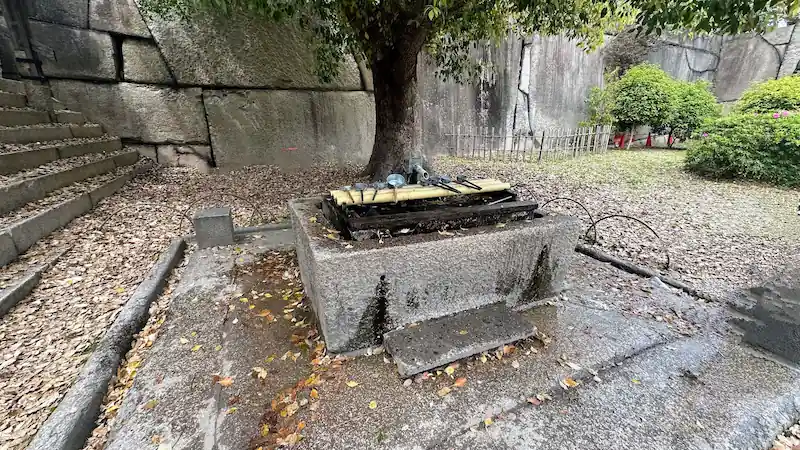
⭐ Recommendation Rating
- Historical Significance: ☆☆☆
- Visual Appeal: ☆☆
- Experiential Value: ☆
The Ginmeisui Well is one of the five wells that once supplied fresh water to the Honmaru (main bailey) of Osaka Castle. It was originally located behind the Honmaru Palace, near the kitchen area, and played a crucial role as a drinking water source for castle officials and guards.
Built during the Tokugawa Shogunate’s reconstruction of Osaka Castle, this well was regarded as one of the most prestigious within the castle—its name, meaning “Silver Radiance Water,” reflects both its high status and the clarity of its water. Naming important wells with characters such as “gold” or “silver” was a practice also found in other castles across Japan to signify their importance.
The well structure and the surrounding granite pavement were originally located behind the headquarters of the former Fourth Army Division (the current site of the Former Osaka City Museum). In 1931, they were relocated to the present site during the reconstruction of the Osaka Castle Main Tower. The well now found on the Small Keep Base is actually the Kinmeisui Well, a separate structure originally located elsewhere within the Honmaru.
Although the original water source of Ginmeisui is now buried beneath a reservoir and no longer visible, the stone-lined well and its surroundings quietly tell the story of what was once the lifeline of the castle.
| Year Built | Early 17th century (Edo period) |
|---|---|
| Builder | Tokugawa Shogunate |
| Structure/Features | Granite-lined well with rectangular stone curb; originally located behind the Honmaru Palace kitchen |
| Renovation/Restoration | Relocated in 1931 during the reconstruction of Osaka Castle’s Main Tower; original stone curb and pavement preserved |
| Current Status | Well curb and surrounding stones preserved; original water source buried and no longer visible |
| Destruction/Damage | Original well site covered during construction; current structure is a relocated remnant |
| Cultural Property Designation | Not designated |
| Remarks | One of five wells supplying water to the Honmaru; name signifies its high status; now located near Sakuramon Gate |
🗺 Address:
1-1 Osaka Castle, Chuo-ku, Osaka City, Osaka Prefecture (behind the former city museum)
🚶 Access
10 minutes on foot (approx. 850m) from Sakuramon Gate
⏳ Estimated
time for visiting: Short tour: About 5 to 10 minutes.
For a thorough tour: About 20 minutes (including other ruins around the Honmaru)
📍 Highlights
🔹 Well structure and stonework: The granite well lining and surrounding pavement are superb examples of Edo-period stonemasonry and are rare architectural remains.
🔹 Symbolic naming: The use of “silver” (銀) in the name signified the well’s elite status and its importance as an infrastructure element during the feudal era.
🔹 Memories of water: Originally a natural spring, the well was once one of the most vital water sources in times of siege—providing critical support for prolonged defense.
🔹 Seasonal scenery: In spring and autumn, the moss-covered stones and fallen leaves around the well evoke a deeper sense of quiet historical beauty.
📌 Trivia
🔹 Surprising historical background: Ginmeisui was established near the palace’s rear and was exclusively managed as a private water source for high-ranking officials and those close to the shogun.
🔹 Little-known detail: When the well was moved to its current location, the original stone pavement was faithfully restored. The meticulous layout and craftsmanship speak to the high prestige and skill involved in its original construction.
🔹 Connection to notable figures: As a water source used by the shogun and high-ranking samurai during their stays, this well embodies the Tokugawa concept of functional beauty in castle design.
Giant Stones of Sakuramon Masugata
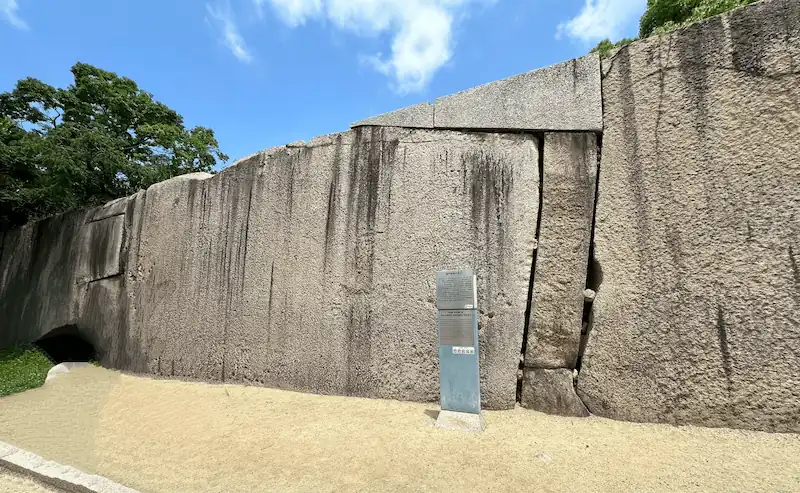
⭐ Recommendation Rating
- Historical Significance: ☆☆☆
- Visual Appeal: ☆☆☆
- Experiential Value: ☆☆
🏛 Overview
As you pass through Sakuramon Gate—the main entrance to the inner citadel of Osaka Castle—you’ll be greeted by a truly awe-inspiring sight: the massive “Tako-ishi” or “Octopus Stone.” This colossal slab is the largest stone within Osaka Castle, boasting a surface area of approximately 59.43 square meters (roughly 36 tatami mats) and an estimated weight of 108 tons. The stone was transported from Bizen (present-day Okayama Prefecture) and installed in 1624 under the direction of Tadataka Ikeda, the feudal lord of the Okayama Domain, as part of the Tokugawa shogunate’s reconstruction efforts. The name “Tako-ishi” comes from the octopus-like patterns that can be seen on its surface.
Inside the Sakuramon Masugata (a square-shaped defensive structure), you’ll also find several other monumental stones, including “Furisode-ishi,” the third-largest stone in the castle grounds, with a surface area of approximately 53.85 square meters. These stones not only served to reinforce the castle’s defenses but also symbolized the Tokugawa shogunate’s immense power and authority to all who entered. The precision with which these stones were transported and fitted together remains a stunning testament to the engineering prowess and labor of the time.
On either side of the Sakuramon Gate are two more legendary stones—“Ryū-ishi” (Dragon Stone) and “Tora-ishi” (Tiger Stone), collectively known as the “Ryūko-ishi” or “Dragon and Tiger Stones.” According to local lore, when these stones are soaked by rain, the figures of a dragon and a tiger appear on their surfaces. These remarkable stones not only add an air of mystique but also serve as invaluable cultural and historical relics that continue to convey the legacy of Osaka Castle. Be sure not to miss them during your visit.
| Year Built | 1624 (Kan’ei 1), early Edo period |
|---|---|
| Builder | Ikeda Tadao, feudal lord of Okayama, under Tokugawa Shogunate orders |
| Structure/Features | Masugata-style square with massive stone walls; includes the largest stone in Osaka Castle, the “Takoishi” (Octopus Stone), measuring 5.5 × 11.7 meters and weighing approximately 108 tons |
| Renovation/Restoration | Stone walls have remained largely unchanged since construction; minor restorations conducted as needed |
| Current Status | Original stone structures intact; accessible to the public |
| Destruction/Damage | Survived multiple conflicts; remains intact |
| Cultural Property Designation | Not individually designated; part of Osaka Castle Park, which includes several Important Cultural Properties |
| Remarks | Features other notable stones such as “Furisode-ishi” (Long-sleeved Kimono Stone); showcases the architectural prowess of the Edo period |
🗺 Address:
1-1 Osaka-jo, Chuo-ku, Osaka City, Osaka Prefecture
🚶 Access:
About a 1minute walk (approx. 20m) from Ginmeisui Well
⏳ Recommended Visit Duration:
Quick highlights: Approx. 30 minutes
In-depth exploration: Approx. 1.5 hours
📍 Highlights:
🔹 Tako-ishi (Octopus Stone): The largest stone in Osaka Castle, with a surface area of approximately 59.43㎡ and an estimated weight of 108 tons.
🔹 Furisode-ishi: The third-largest stone in the castle grounds, with a surface area of approximately 53.85㎡.
🔹 Ryūko-ishi (Dragon and Tiger Stones): Located on either side of Sakuramon Gate—when wet, the surfaces are said to reveal the forms of a dragon and a tiger.
📌 Trivia:
Unexpected Historical Insight: These massive stones were transported by regional lords at the order of the Tokugawa shogunate as part of the castle’s reconstruction—serving as a clear demonstration of centralized power and control.
Hidden Detail: The octopus-like patterns on Tako-ishi are believed to be the result of natural weathering and the mineral composition of the stone.
Famous Connection: Tadataka Ikeda, the feudal lord who oversaw the transport and installation of Tako-ishi, was the grandson of Tokugawa Ieyasu and played a key role in the shogunate’s administration.
The Camphor Tree Allegedly Planted by Toyotomi Hideyoshi
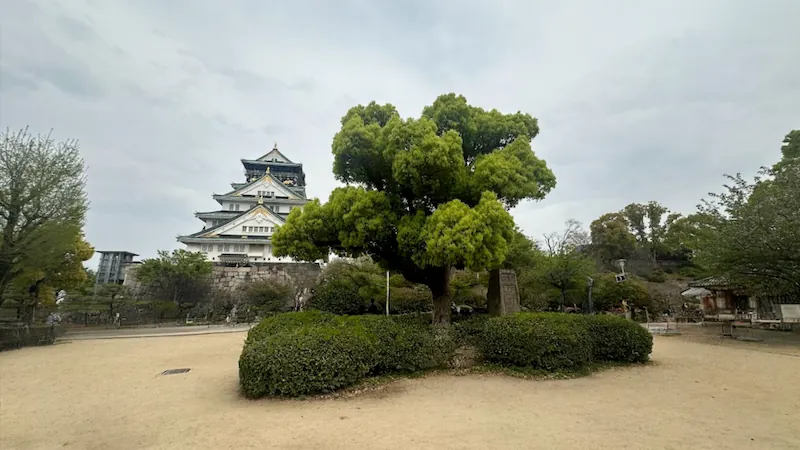
⭐ Recommendation Rating
- Historical Significance: ☆
- Visual Appeal: ☆☆
- Experiential Value: ☆
🏛 Overview
Within Osaka Castle Park stands a towering camphor tree, widely known as the “Camphor Tree Planted by Toyotomi Hideyoshi.” Said to be approximately 400 years old, this majestic tree has long captivated visitors as a symbolic remnant of the castle’s origins. According to popular legend, Hideyoshi himself planted the tree during the construction of Osaka Castle. However, historical records reveal a different story: the tree was actually planted in March 1898 (Meiji 31) by Mataji Ogawa, then commander of the Imperial Japanese Army’s 4th Division, which was stationed at Osaka Castle at the time. This little-known fact illustrates how the narrative of Osaka Castle has evolved over the centuries.
Today, the camphor tree remains a popular photo spot, often framed alongside the iconic Osaka Castle tower. It offers visitors a serene blend of history and nature, making it a must-see feature within the park grounds.
| Year Planted | March 1898 (Meiji 31) |
|---|---|
| Planter | Mataji Ogawa, Commander of the Imperial Japanese Army’s 4th Division |
| Structure/Features | Large camphor tree (Cinnamomum camphora) with a broad canopy; prominent landmark within Osaka Castle Park |
| Renovation/Restoration | Regular maintenance and care by park authorities; no major restorations recorded |
| Current Status | Healthy and thriving; accessible to the public |
| Destruction/Damage | None; survived World War II without damage |
| Cultural Property Designation | Not individually designated; part of Osaka Castle Park |
| Remarks | Commonly believed to have been planted by Toyotomi Hideyoshi; serves as a symbolic connection to the castle’s origins |
🗺 Address:
1-1 Osaka-jo, Chuo-ku, Osaka City, Osaka Prefecture
🚶 Access:
About a 2-minute walk (approx. 150m) from Giant Stones of Sakuramon Masugata
⏳ Recommended Visit Duration:
Quick stop: Approx. 15 minutes
Leisurely exploration: Approx. 45 minutes
📍 Highlights:
🔹 Camphor Tree: A massive camphor tree, believed to be around 400 years old, located within Osaka Castle Park.
🔹 Main Keep (Tenshukaku): The symbolic centerpiece of Osaka Castle, featuring extensive historical exhibits.
🔹 Nishinomaru Garden: A beautifully landscaped Japanese garden offering seasonal scenery throughout the year.
📌 Trivia:
Surprising Historical Fact: Though commonly believed to have been planted by Toyotomi Hideyoshi, this camphor tree was actually planted during the Meiji era.
Little-Known Detail: Near the tree, remnants of the original stone walls from Hideyoshi’s time still remain, offering a glimpse into the advanced stonework techniques of the era.
Famous Connection: The tree was planted by Mataji Ogawa, commander of the 4th Division of the Imperial Japanese Army during the Meiji period.
Kinzo (Gold Storehouse)
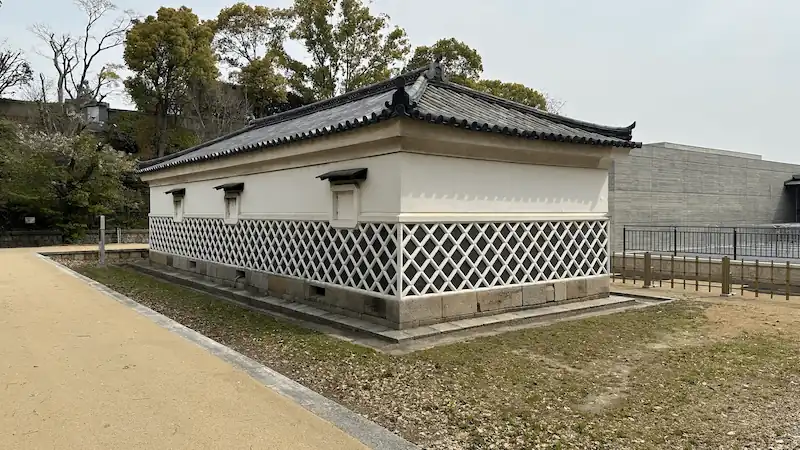
⭐ Recommendation Rating
- Historical Significance: ☆☆☆
- Visual Appeal: ☆☆
- Experiential Value: ☆
🏛 Overview
The Kinzo, also known as the Gold Storehouse, is a fortified treasure repository built within Osaka Castle by the Tokugawa Shogunate. Designed with high-level protection against fire, moisture, and theft, it was a critical facility for safeguarding the shogunate’s precious assets such as gold and silver coins. As its name suggests, it functioned as a financial stronghold, supporting the economic core of Tokugawa governance in western Japan.
The original structure was built as a two-story building in 1751. However, in 1837, it was remodeled into a single-story structure for improved practicality and durability. Throughout the building, you can find thoughtful features that reflect its security purpose—one of the most striking is the namako-kabe (sea cucumber wall), a white-and-black lattice-style plaster wall known for both its visual elegance and functional insulation.
In 1960, the Kinzo underwent full dismantling and restoration. Today, it stands as a rare example of Edo-period functional architecture that combines defensive strength and aesthetic craftsmanship.
| Year Built | 1751 (Hōreki 1); remodeled in 1837 (Tenpō 8) |
|---|---|
| Builder | Tokugawa Shogunate |
| Structure/Features | Single-story earthen storehouse with namako-kabe (sea cucumber wall) plasterwork, thick tiled roof, and iron-reinforced doors and windows for fire and theft protection |
| Renovation/Restoration | Converted from original two-story design to single-story in 1837 for enhanced durability; dismantled and restored in 1960 |
| Current Status | Original structure preserved; designated as an Important Cultural Property |
| Destruction/Damage | None recorded; survived natural disasters and wartime intact |
| Cultural Property Designation | Important Cultural Property (Japan) |
| Remarks | Functioned as the Tokugawa Shogunate’s western treasury; featured advanced humidity control and security measures for storing gold and silver currency |
🗺 Address:
1-1 Osakajo, Chuo-ku, Osaka City, Osaka Prefecture (near Kinzomae Square)
🚶 Access
1 minutes on foot (approx. 55m) from The Camphor Tree Allegedly Planted by Toyotomi Hideyoshi
⏳ Estimated time for sightseeing
: Short-term sights: About 10 minutes.
For a thorough tour: About 20 to 30 minutes (including visiting the nearby Sengan-yagura Tower and Sakuramon Gate).
📍 Highlights
🔹 Elegant namako-kabe walls: These decorative plaster walls feature alternating black tiles and white seams. Aside from their visual appeal, they also offer enhanced fire and moisture resistance.
🔹 Robust construction: The thick tiled roof, iron-reinforced windows and doors, and tightly sealed structure all demonstrate measures taken to protect valuable contents from fire, theft, and the elements.
🔹 Traces of structural modification: Evidence remains that the building was once two stories tall. The conversion into a single-story structure reflects changing needs and practical decision-making by the shogunate.
🔹 Seasonal charm: In spring, the cherry blossoms and surrounding greenery offer a soft contrast to the solid stone structure. In autumn, the namako walls softly glow in the slanting afternoon light.
📌 Trivia
🔹 Surprising historical background: The Kinzo symbolizes Osaka Castle’s role as the economic and military center of western Japan, and it was a key part of the Tokugawa Shogunate’s regional financial administration.
🔹 Little-known fact: The Kinzo is equipped with hidden ventilation and humidity control systems—remarkable engineering for its time. These features, although subtle from the outside, were vital for preserving the coins and valuables inside.
🔹 Connection to notable figures: The structure is believed to have been constructed during the reign of Tokugawa Yoshimune, and likely formed part of his broader financial reform strategy during the Kyōhō Reforms, aimed at stabilizing the shogunate’s economy.
Toyotomi Hideyoshi’s Ishigaki-kan (Stone Wall Exhibition Hall at Osaka Castle)
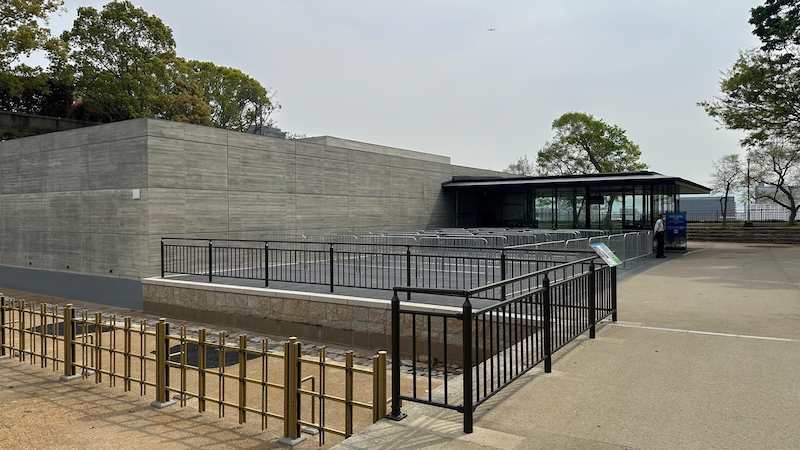
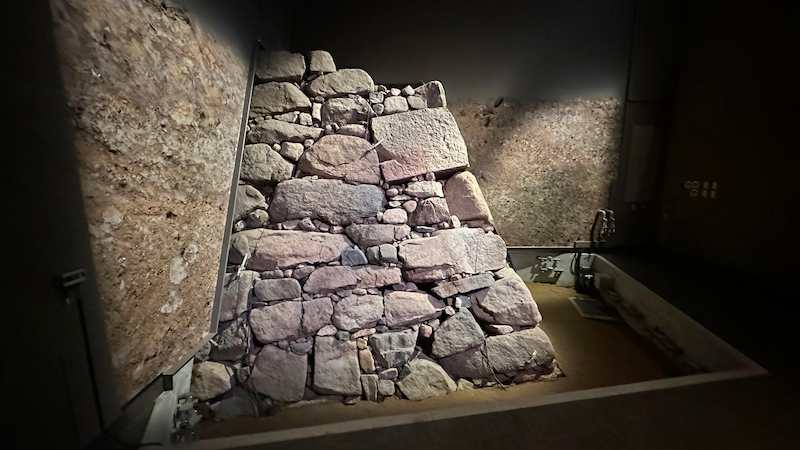
⭐Recommendation Rating
- Historical Significance: ☆☆☆
- Visual Appeal: ☆☆☆
- Experiential Value: ☆☆☆
Toyotomi Ishigaki-kan is a modern underground exhibition space where visitors can view the original stone walls of Toyotomi Hideyoshi’s 16th-century Osaka Castle, uncovered during excavations in 1984. These ancient walls had been buried under more than six meters of earth during the Tokugawa shogunate’s reconstruction of the castle following the Summer Siege of 1615.
This recently opened facility offers a rare glimpse into the stone wall that protected the Tsume-no-Maru (詰ノ丸)—the most important residential area of Hideyoshi’s castle, where he lived with his wife Nene and, later, where Lady Yodo and their son Hideyori resided.
In the subterranean exhibition hall, visitors can closely examine the stonework techniques such as Nozurazumi (野面積み), scorch marks from wartime, drainage stones (裏込石), and repurposed temple foundations (転用石) as they were originally left when buried. Multilingual displays provide detailed explanations.
This site offers a tangible and emotional connection to the buried legacy of Toyotomi Osaka Castle—a moment in history once lost, now revealed.
🎟️ Admission & Visitor Info
- Admission: Included with Osaka Castle Main Tower ticket (¥1,200 adults)
- Hours: 9:00 AM – 6:00 PM (last entry 5:30 PM)
- Closed: December 28 – January 1
- Restrooms: Not available inside the exhibit
- Note: The exhibit may close without notice depending on stone wall conditions
🔗 Official Website (JP): https://www.osakacastle.net/toyotomi_stone_wall/
| Year Built | Recently opened; walls discovered in 1984; originally built in 1583 |
|---|---|
| Builder | Stonework: Toyotomi Hideyoshi; Facility: Osaka City |
| Structure/Features | Subterranean viewing area, stone wall from Tsume-no-Maru, Nozurazumi, reuse stones |
| Renovation/Restoration | Preserved after excavation in 1984; facility constructed above the exposed stone wall |
| Current Status | Open to the public as part of the Osaka Castle Museum admission |
| Destruction/Damage | Buried under 6 meters of earth during Tokugawa reconstruction after 1615 |
| Cultural Property Designation | Part of Osaka Castle Historic Site |
| Remarks | Exhibits authentic stonework from the core of Toyotomi Osaka Castle |
🗺 Address:
1-1 Osakajo, Chuo Ward, Osaka, 540-0002
🚶 Access:
Approx. 1-minute walk from Kinzo (Gold Storehouse)
⏳ Recommended Visit Duration:
- Quick viewing: ~10 minutes
- Full experience with displays: ~20–30 minutes
📍 Key Highlights
- View Real Toyotomi Stone Walls: From the castle’s most central and private area—Tsume-no-Maru
- Fire Scars from the Siege: See traces of the 1615 Summer Campaign still marked on the stones
- Primitive and Powerful Technique: Nozurazumi stone stacking, left uncut and raw
- Burial by Tokugawa: 6 meters of earth laid to hide the Toyotomi legacy
- Intimate Insight: A direct, physical link to Hideyoshi’s original Osaka Castle
📌 Trivia
- The Hidden Castle: What you see above ground is Tokugawa Osaka Castle. What you see here is Toyotomi’s—buried, yet enduring.
- Layered Legacy: The exhibit vividly contrasts the ambition of Hideyoshi with the suppression by the Tokugawa regime.
Zannen-ishi:The Stones That Fell Short: Untold Stories Beneath Osaka Castle
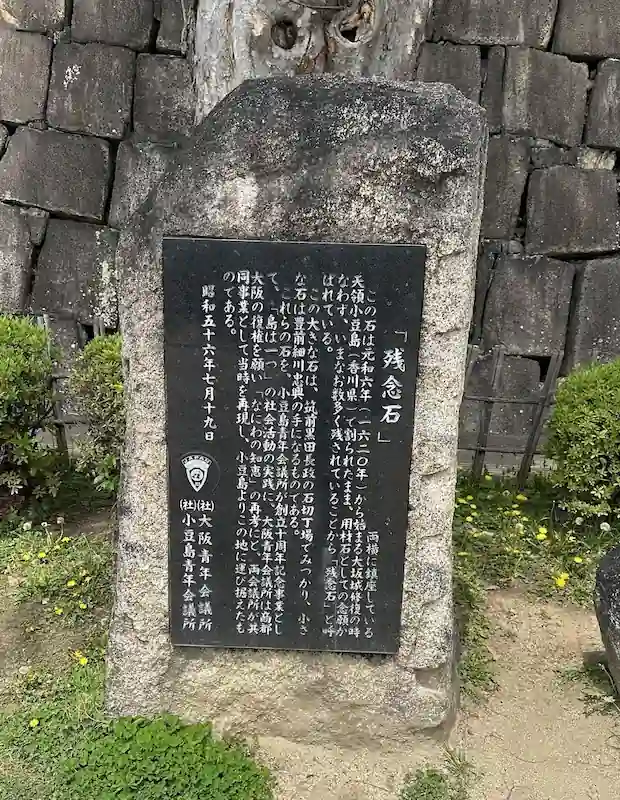
⭐ Recommendation Rating
- Historical Significance: ☆☆
- Visual Appeal: ☆
- Experiential Value: ☆
During the Edo-period reconstruction of Osaka Castle by the Tokugawa shogunate, countless massive stones were painstakingly quarried and transported to build the imposing stone walls. Yet, not all of them made it. These are known as “The Stones That Fell Short”—massive boulders that, for one reason or another, were never used in the final construction. Whether they cracked during transport, were dropped along the way, or became obsolete due to design changes, these stones remain silent witnesses to the effort, labor, and ambition behind the castle’s creation.
The most famous of these stones sits just beside the main keep. Still bearing the engraved marks of the Kuroda clan (Fukuoka) and Hosokawa clan (Kumamoto), it’s a powerful reminder that feudal lords from across Japan were mobilized to support the Tokugawa regime’s grand architectural project. These engraved symbols turn each stone into a piece of living history—monuments to the hands and hierarchies that shaped Osaka Castle.
Today, many of these stones are displayed in the Kokuin-ishi Hiroba (“Inscribed Stones Plaza”), where visitors can compare over 80 markings from different feudal domains. The exhibit offers a rare, tangible insight into the logistics and scale of the Tokugawa building campaign. Unlike the earlier, more spontaneous stonework of the Toyotomi era, these stones showcase the Tokugawa period’s calculated, large-scale approach to fortress construction.
| Year Quarried | Early 17th century (circa 1620s) |
|---|---|
| Quarried By | Various feudal domains under Tokugawa Shogunate orders |
| Structure/Features | Massive stones with chiseled surfaces and engraved clan crests; intended for castle walls but left unused |
| Reason for Abandonment | Cracks during transport, design changes, or logistical challenges |
| Current Status | Displayed in areas like the Inscribed Stones Plaza; some remain along original transport routes |
| Destruction/Damage | None; preserved as historical artifacts |
| Cultural Property Designation | Not individually designated; part of Osaka Castle Park’s historical landscape |
| Remarks | Serve as tangible reminders of the extensive efforts in Osaka Castle’s construction; some stones bear clan marks from domains like Kuroda and Hosokawa |
🗺 Address:
1-1 Osaka-jo, Chuo-ku, Osaka City, Osaka Prefecture
🚶 Access:
About a 3-minute walk (approx. 190m) from Toyotomi Hideyoshi’s Ishigaki-kan (Stone Wall Exhibition Hall at Osaka Castle)
⏳ Recommended Visit Duration:
Quick highlights: Approx. 20 minutes
In-depth exploration: Approx. 1 hour
📍 Highlights:
🔹 The Stone That Fell Short (Southwest of the Main Keep): A massive unused stone still bearing engraved family crests from contributing domains.
🔹 Inscribed Stones Plaza: Over 80 stones on display, featuring daimyō crests and interpretive signage explaining the transport routes and construction process.
🔹 Scattered Sites: Similar stones can be found in various areas around the castle grounds, including Nishinomaru Garden and near the Otemon Gate.
📌 Trivia:
Unexpected Historical Insight: Many of these stones were transported by boat from quarries in Shodoshima (Kagawa Prefecture) and Inujima (Okayama Prefecture). Some were abandoned after shipwrecks or failed landings.
Little-Known Detail: Shodoshima is home to the Osaka Castle Remaining Stone Memorial Park, where stones originally intended for the castle still remain on site.
Famous Connection: Stone procurement was overseen by prominent feudal lords such as Nagamasa Kuroda of Fukuoka and Tadatoshi Hosokawa of Kumamoto, whose family crests are still visible on the stones today.
Kinmeisui Well House
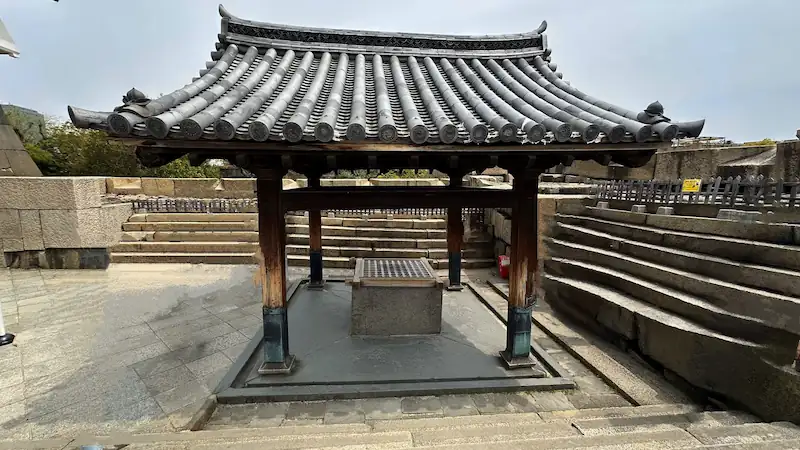
⭐ Recommendation Rating
- Historical Significance: ☆☆☆
- Visual Appeal: ☆☆☆
- Experiential Value: ☆☆
🏛 Overview
The Kinmeisui Well House, located atop the small keep platform within the tenshu-kuruwa (main keep enclosure) of Osaka Castle, was a vital emergency water source—a true lifeline during a siege. Strategically placed beneath the Main Tower, it ensured that fresh water could be accessed even during prolonged battles, making it one of the castle’s most important and tactical features.
The name “Kinmeisui” (Golden Bright Water) is said to derive from the clarity and brilliance of the water, which once appeared golden under the sunlight. An architectural survey conducted during restoration work in 1969 revealed that the well was originally constructed in 1626 (Kan’ei 3), the same year as the Tokugawa-era main keep. This means the Kinmeisui Well House is an extremely rare and authentic remnant from the original construction of Tokugawa Osaka Castle.
| Year Built | 1626 (Kan’ei 3), early Edo period |
|---|---|
| Builder | Tokugawa Shogunate under Tokugawa Hidetada |
| Structure/Features | 33-meter-deep well covered by a gabled roof structure; stone-lined shaft with a carved single-stone well curb |
| Renovation/Restoration | Underwent dismantling and repair in 1969; preserved in its original form |
| Current Status | Original structure; designated as an Important Cultural Property |
| Destruction/Damage | Survived the 1665 lightning strike that destroyed the main keep |
| Cultural Property Designation | Important Cultural Property (Japan) |
| Remarks | Originally known as “Ōgonsui” (Golden Water); served as a vital water source during sieges |
🗺 Address:
1-1 Osaka Castle, Chuo-ku, Osaka City, Osaka Prefecture (on the small castle tower)
🚶 Access
Approximately 1 minutes on foot (approximately 36m) from Zannen-ishi:The Stones That Fell Short: Untold Stories Beneath Osaka Castle
⏳ Estimated
time for visiting: Short tour: About 10 minutes
For a thorough tour: About 20 to 30 minutes (including the castle tower base)
📍 Highlights
🔹 Architecture of the well house: The roofed hut built over the well is constructed with cut-stone walls and features wooden posts and a traditional roof, reflecting Edo-period craftsmanship. Details show careful design to protect the well from rain and debris.
🔹 Unity with the castle platform: Positioned at one of the highest points in the castle enclosure, the well was designed with both water-drawing and defensive considerations in mind.
🔹 Same construction date as the main keep: Built in 1626, the well was part of the original Tokugawa plan for Osaka Castle—underscoring its significance as more than just a utility.
🔹 Seasonal atmosphere: In spring, the surrounding cherry blossoms frame the well house beautifully against the stone base. In autumn, sunlight filtering through the trees creates a tranquil, historically rich scene.
📌 Trivia
🔹 Surprising historical background: The name “Kinmeisui” comes from records describing the well’s remarkably clear and reflective water, which appeared to shine like gold. This highlights the well’s symbolic and practical value.
🔹 Little-known fact: The well is approximately 33 meters deep. When combined with the elevation of the castle platform, it reflects the use of advanced well-digging techniques for the time. It was likely seen as the last-resort water source in times of crisis.
🔹 Connection with famous figures: Constructed during the reign of Tokugawa Iemitsu, Kinmeisui was part of the massive reconstruction project of Osaka Castle. It represents the peak of Tokugawa-era engineering and planning.
Osaka Castle Main Tower
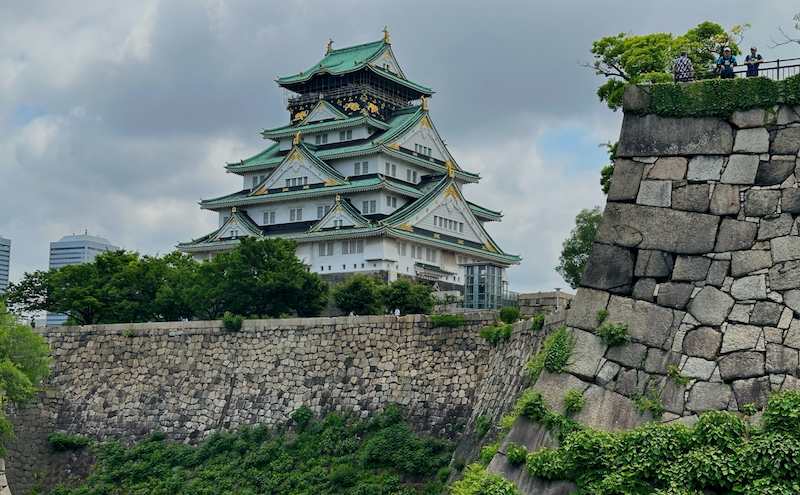
⭐ Recommendation Rating
- Historical Significance: ☆☆☆
- Visual Appeal: ☆☆☆
- Experiential Value: ☆☆☆
🏛 Overview
The Osaka Castle Main Tower (Tenshukaku) is the iconic symbol of Osaka. The current structure is the third iteration, following the original built by Toyotomi Hideyoshi and the second rebuilt by the Tokugawa Shogunate. The present tower was reconstructed in 1931, funded entirely by public donations from Osaka’s citizens—a remarkable achievement during the Great Depression. It became the first main keep in Japan to be rebuilt using modern construction methods, making it historically significant in both architecture and civic pride.
The exterior design is based on the opulent Toyotomi-era keep, using historical materials such as the “Osaka Summer Campaign Folding Screen” (now housed inside the tower), passed down through the Kuroda family, feudal lords of Fukuoka. Thanks to these references, the main tower was faithfully restored with a black base adorned with golden shachihoko (roof ornaments) and intricate decorative details, resulting in a powerful and majestic presence.
Inside, the tower functions as a museum dedicated to the life and legacy of Toyotomi Hideyoshi and the Sengoku period. It houses an extensive collection of armor, swords, screens, historical documents, and more. The museum is regarded as one of Japan’s finest for its Toyotomi-period artifacts, attracting history enthusiasts and international tourists alike. In 2022, it was registered as a Tangible Cultural Property of Japan.
| Year Built | Originally completed in 1597; current structure rebuilt in 1931 |
|---|---|
| Builder | Originally by Toyotomi Hideyoshi; current reconstruction initiated by Osaka citizens |
| Structure/Features | Five-tiered, eight-story tower (55 meters tall) with white plaster walls, green-tiled roofs, and gold leaf ornamentation; includes shachihoko (mythical tiger-headed fish) and fusetora (crouching tiger) decorations |
| Renovation/Restoration | Reconstructed in 1931 using ferroconcrete; major restoration completed in 1997 to restore Edo-period appearance |
| Current Status | Functioning as Osaka Castle Museum; interior includes exhibits on Toyotomi Hideyoshi and the castle’s history |
| Destruction/Damage | Original tower destroyed in 1615 during the Siege of Osaka; rebuilt in 1628, then destroyed by lightning-induced fire in 1665; current structure survived WWII with minor damage |
| Cultural Property Designation | Registered Tangible Cultural Property (1997) |
| Remarks | Offers panoramic views of Osaka from the 8th-floor observation deck; features a replica of the Golden Tea Room and other historical artifacts |
🗺 Address:
1-1 Osaka Castle (Castle Tower), Chuo-ku, Osaka City, Osaka Prefecture
🚶 Access
: Approximately 1 minutes on foot (approximately 2 m) from Kinmeisui Well House
⏳ Estimated time for visiting
: Short visits: About 45 minutes to 1 hour.
For a thorough tour: About 1.5 to 2 hours (including the exhibits and the observation deck on the top floor of the castle tower)
📍 Highlights
🔹 Exterior of the keep: Featuring white plaster walls, brilliant golden ornaments, and detailed gegyo decorations, the castle’s appearance reflects the power and aesthetic sensibilities of Sengoku warlords.
🔹 Exhibition floors (interior): Displays include Hideyoshi’s armor, gold-leaf tiles, folding screens, swords, and a model of the castle town. The famed “Osaka Summer Campaign Folding Screen” is a must-see.
🔹 Observation deck (top floor): At approximately 50 meters above ground, the panoramic view of Osaka is breathtaking—especially during cherry blossom season and autumn foliage.
🔹 Seasonal highlights:
In spring, cherry trees in full bloom surround the castle, offering dramatic views from below and above. In autumn, vibrant foliage creates a vivid contrast with the castle’s white and gold.
📌 Trivia
🔹 Surprising historical background: Despite the severe economic depression of the early Showa period, the entire reconstruction cost of the main tower was covered by citizen donations, making it a unique example of a castle revived by civic effort.
🔹 Little-known fact: Although the exterior is modeled after the Toyotomi period, the interior is a modern reinforced concrete structure, complete with elevators—a fusion of tradition and modernity.
🔹 Famous connections: Many prominent Osaka figures and entrepreneurs contributed to the 1931 reconstruction. The “Osaka Summer Campaign Folding Screen,” which inspired the design, is a historically significant artifact recognized worldwide for its vivid depiction of Sengoku warfare.




comment